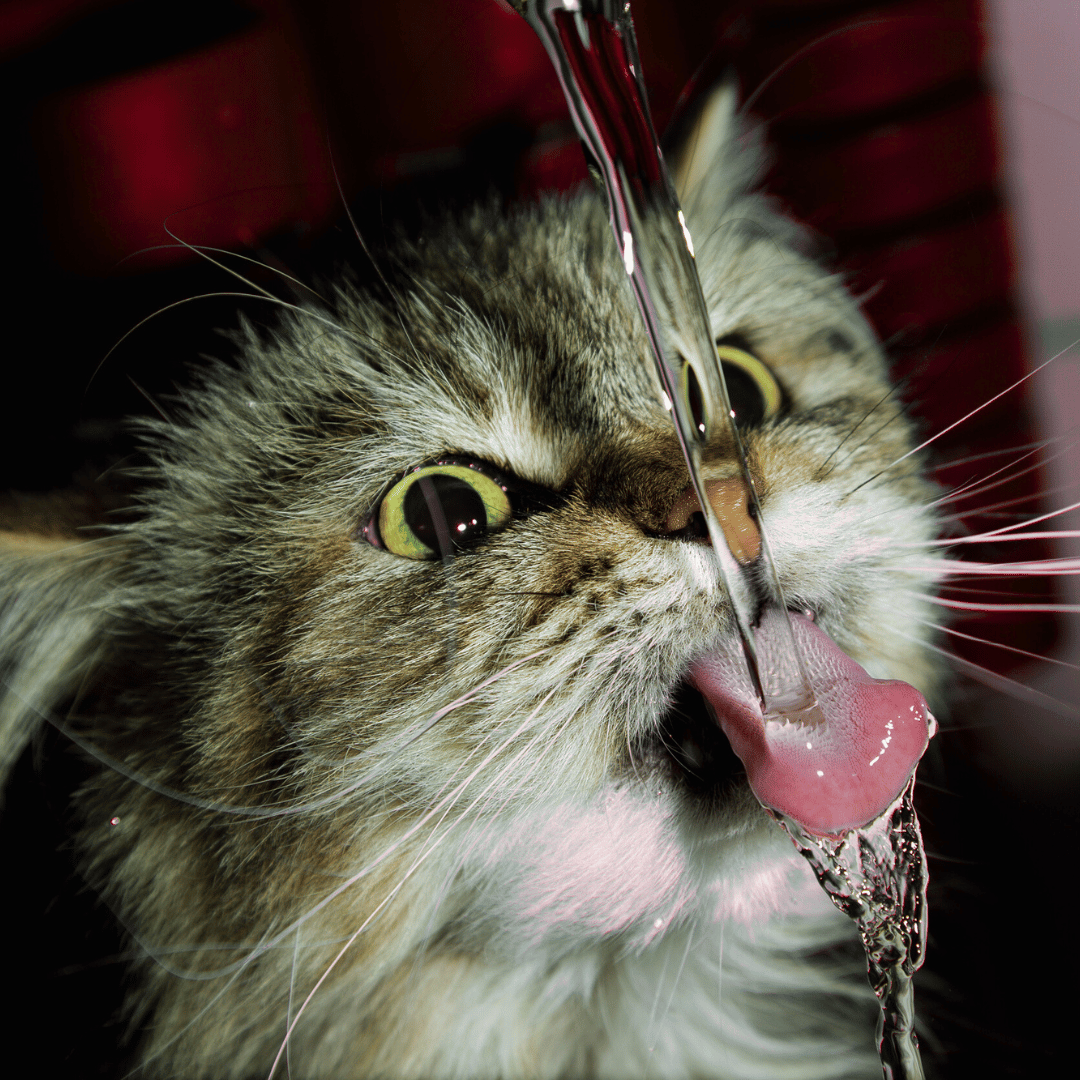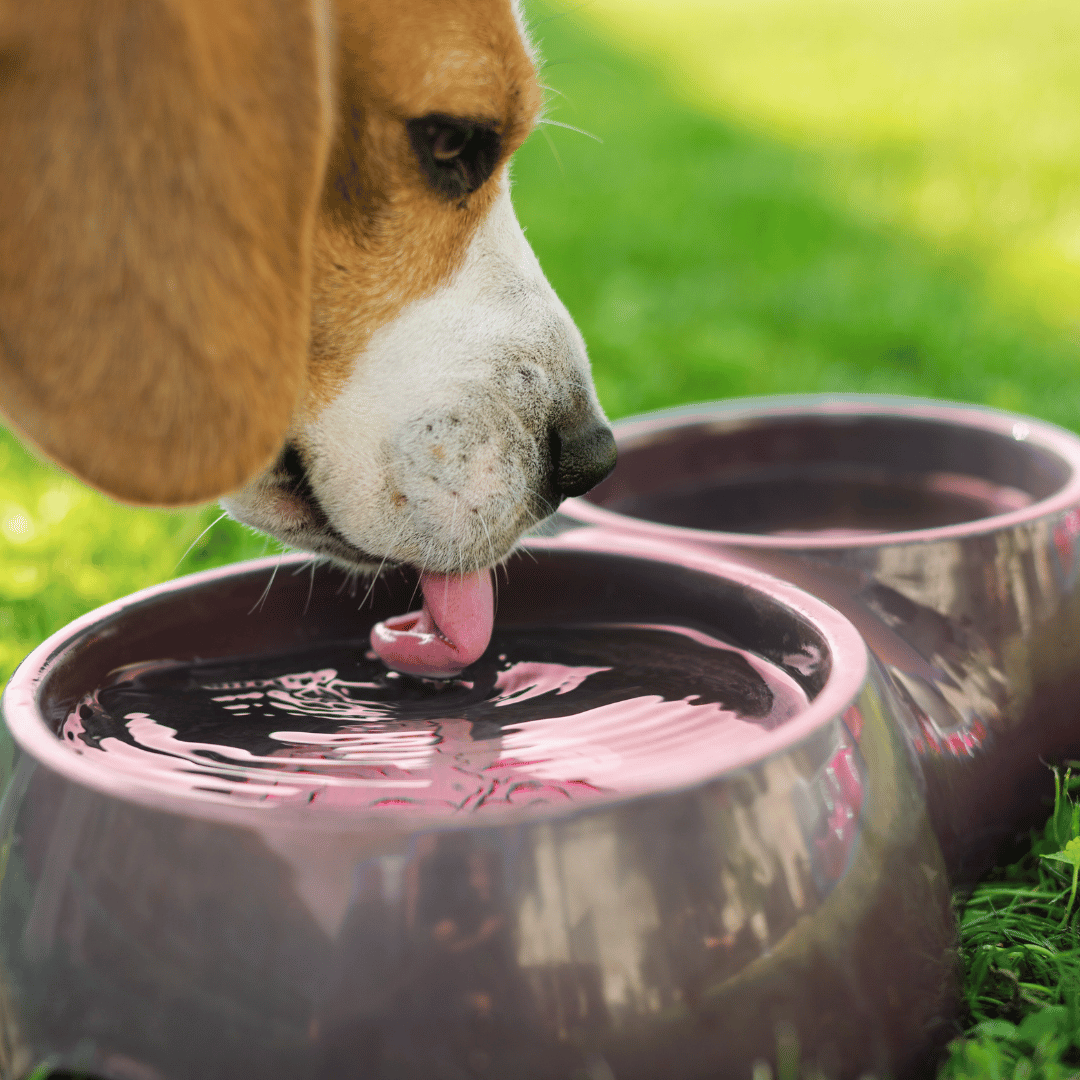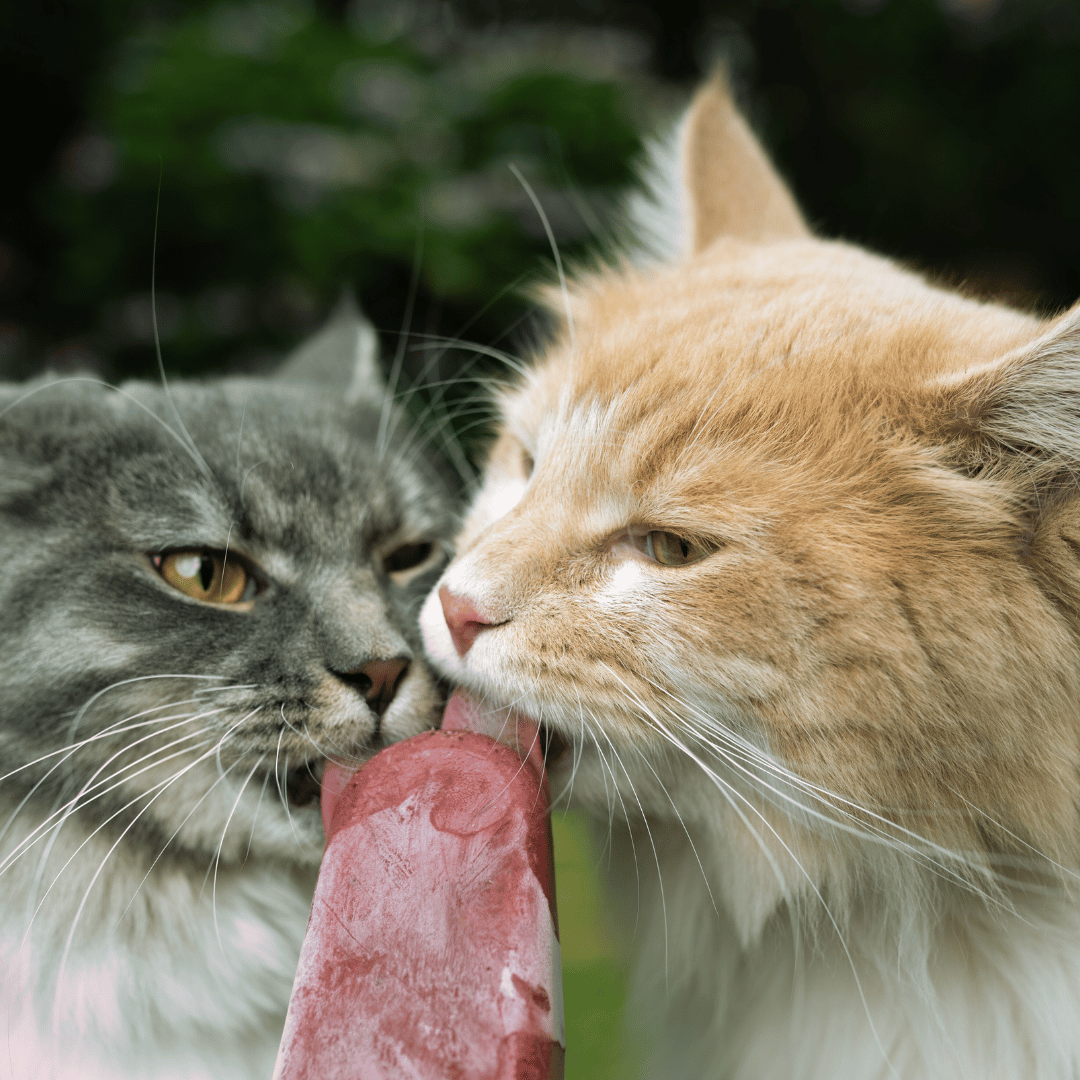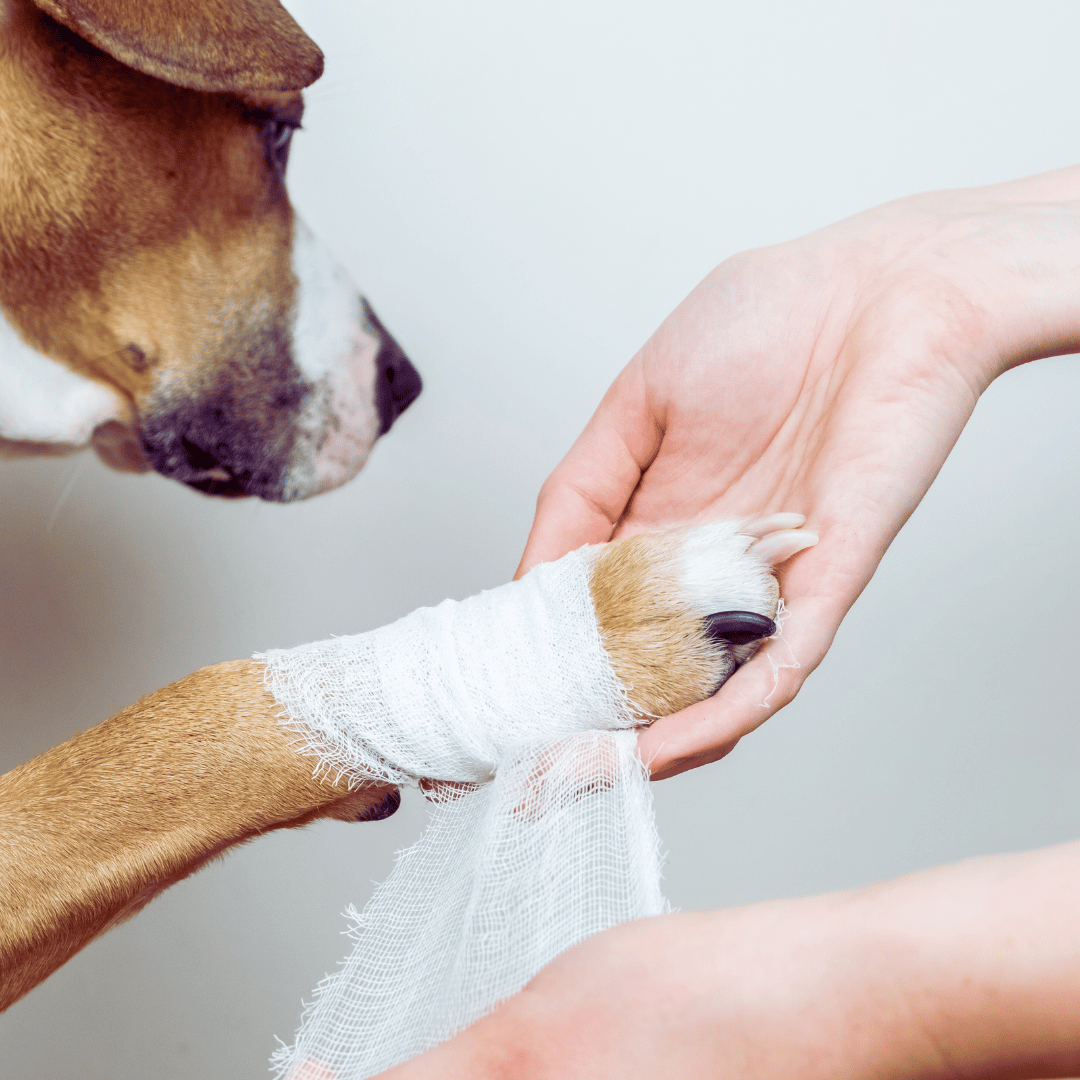July brings sunshine, vacations, and dangerous heat. While we plan barbecues and beach days, our pets are dealing with scorching sidewalks, sweltering backyards, and fireworks that send them into hiding. Every summer, shelters and veterinary clinics see an increase in heat-related emergencies, many of which are preventable.
In this article, we’ll share simple, vet-backed ways to keep your pets safe and cool. From hydration hacks to paw protection and heatstroke warning signs, you’ll walk away with tips that could save a life.
Hydration is the First Line of Defense
Why Hydration Matters Differently for Dogs and Cats
- Dogs rely on panting and limited sweating through paw pads to cool down. In intense heat and humidity, their cooling efficiency drops, increasing dehydration risk2 3.
- Cats, with a normal internal temperature of ~101.5°F (38.6 °C), don’t pant unless extremely overheated and only sweat through paw glands, making them less efficient at cooling 4.
- Without intervention, cats may resist drinking, especially if their water bowl is inconvenient or unappealing 5. We always recommend fountain water bowls since cats have been evolved to associate still water with danger

Hydration Strategies You Can Use
1. Offer Wet Food — Especially for Cats
Switching to canned or wet food significantly boosts water intake. Wet food typically contains 65–80 % moisture, compared to 10–20 % in kibble6. For cats who drink less naturally this can be a vital hydration source4.

2. Provide Multiple Water Stations

- Use multiple water bowls in shaded areas both inside and outside. Pets, especially cats, may avoid areas near noise, food, or litter boxes 5.
- Consider a pet water fountain. Cats often prefer running water over still water7.
3. Add Ice Cubes or Broth Treats

4. Track Intake and Know Needs
- Dogs: ~60–80 ml per kg of body weight daily6.
- Cats: ~40–60 ml per kg, plus water from wet food 4.
- If pets drink noticeably less—or show signs like sunken eyes, dry gums, lethargy, or rapid breathing—observe and act fast 9.
Quick Checklist: Hydration Best Practices
- Provide fresh, cool water 24/7 in shaded, quiet areas.
- Offer wet food daily, especially for cats who refuse to drink water
- Use bowls and fountains cleaned daily to encourage use.
- Include ice cubes or broth pops as treats.
- Bring water on walks—aim for small, frequent sips, not large gulps10.
Shade and Ventilation: Creating a Cool Environment
Even with plenty of water, pets can still overheat if they don’t have access to shade and fresh air. Direct sun exposure, especially during peak hours (10 a.m. to 4 p.m.), can turn a pleasant day into a medical emergency—and while this may be a prime time for us to catch a tan, it’s a significant hazard for our pets.
How Pets Naturally Stay Cool (And How We Can Help)
- Dogs pant to lose heat and rely on airflow. You can assist by:
- Gently wiping their ears or body with a damp cloth.
- Offering shade near fans or cool basements.
- Cooling down with misting or damp towel rubs.
- Gently wiping their ears or body with a damp cloth.
- Cats groom themselves to release heat and may stretch out on cool surfaces. Help them stay cool by:
- Providing low, wide bowls of cool water and ceramic or stone resting spots.
- Leaving curtains or blinds partially closed to reduce heat indoors.
- Setting up low-lying cardboard or ceramic tiles for lounging.
- Providing low, wide bowls of cool water and ceramic or stone resting spots.
Simple Shade & Ventilation Tips
- Use natural shade or portable covers like trees, tarps, umbrellas, or shade tents to block harsh sun.
- Keep pets indoors during the hottest parts of the day, especially senior animals or those with thick coats or respiratory issues.
- Set up fans or use air conditioning to keep indoor air moving.
- Lay out cooling mats or damp towels on tile floors or shaded porches for dogs and cats to lie on.
- Never leave pets in cars, even for a short time. Temperatures inside a vehicle can rise nearly 20 degrees in just 10 minutes. Cracking the windows will not help.
Reminder
Shade + airflow + hydration = your pet’s heat safety formula. Together, these elements form the foundation of your pet’s protection in summer.
Paw and Skin Protection
Common Signs of Sunburn & Paw Burns
- Sunburn appears as redness, flakiness, or blistering in thinly-furred areas; affected skin may feel warm and sensitive to the touch14 15.
- Paw-pad burns can cause limping, excessive licking, blistering, cracked or peeling skin, and discomfort when walking11 16.

Breed-Specific Heat and Burn Risks
- Brachycephalic breeds (e.g., Bulldogs, Pugs, Shih Tzus) struggle to cool via panting and often overheat in summer5 6.
- Thick-coated breeds (like Huskies or Malamutes) retain heat longer and require extra cooling measures7.
- Long-haired cats (e.g., Persians, Maine Coons, All Domestic Long Hairs) can overheat easily and benefit from shade and regular grooming17.
- Hairless or thin-coated cats (such as Sphynx or Cornish Rex) lack natural UV protection and are especially vulnerable to sunburns 13 15.
Paw Pad Care After Exposure

- Cool the paw by running it under cool (not cold) water for 10–15 minutes to soothe and clean16.
- Apply a veterinarian-approved antibiotic ointment or balm to promote healing. Avoid on open wounds unless directed by your veterinarian14.
- Protect the paw by loosely wrapping it and considering a sock or bootie. The long feared “cone of shame” is also a good option here 11 16.
- Monitor progress daily – minor burns may heal in a week; more severe cases need vet evaluation if swelling, discharge, or infection develops11 16.
Prevention Tips Summary
- Test pavement with your hand or bare foot for 10 seconds. If it’s too hot for you, it’s too hot for their paws18.
- Walk pets early or late to avoid the midday heat.
- Use booties or paw wax for protection on hot surfaces.
- Apply pet-safe sunscreen to exposed skin on thin-coated or hairless pets19.
- Create shaded, cool rest areas for pets to escape the sun.
Recognizing and Responding to Heatstroke
Common Signs of Heatstroke in Pets
- Excessive panting or drooling
- Bright red, pale, or bluish gums
- Lethargy, disorientation, or stumbling
- Vomiting, diarrhea, or drooling blood
- Seizures, collapse, or unconsciousness
Veterinarian-Recommended First Aid Steps
- Move your pet to shade or indoors and choose a cool spot right away5 6.
- Begin gradual cooling with cool (not cold) water on the fur. Focus on belly, armpits, and paws and avoid ice baths7 5. Cooling too quickly can be harmful to a pet with heatstroke (people too).
- Use a fan or another form of airflow to reduce temperatures in the house7 8. If you have a way where a door or window face eachother on two opposite sides of a room, that cross breeze can be a huge help.
- Offer small, frequent sips of cool water, but avoid forcing it if they’re disoriented6 9.
- Monitor body temperature, aiming to reduce it to about 103 °F (39.5 °C); stop cooling once reached to prevent hypothermia7 10.
- Seek immediate veterinary care, even if symptoms appear to improve—organ damage could still be occurring5 11.
Why Fast Action Matters for Pets with Heatstroke
When in Doubt, Call for Help
- Don’t wait to contact your vet. If you are noticing any signs of heatstroke (even the most minimal signs) call immediately.
- At the clinic, vets may administer IV fluids, oxygen, sedation, and monitor blood pressure and organ function4 5.
- Organs damaged by heatstroke may show late so follow-up visits are a must4.
Recommended 24/7 Vet Clinics in your area
Ventura County
Ventura | Camarillo | Oxnard | Thousand Oaks | Simi Valley | moorpark
Los Angeles County
Los Angeles | Hollywood| Burbank | Glendale | Santa Clarita | Pasadena | San Fernando
Bonus Tips: Summer Activities That Help Pets Stay Cool
There are plenty of fun ways to help your furry friends beat the heat while bonding at the same time. These simple, vet-approved activities provide enrichment, hydration, and cooling.
Easy Ways to Stay Cool and Have Fun
- Offer frozen treats: Try ice cubes made from low-sodium broth, watermelon puree, or plain water with a few pet-safe berries inside2.
- Set up a kiddie pool or sprinkler: Most dogs (and some bold cats) love supervised water play when temperatures soar.
- Create indoor adventure zones: Use boxes, tunnels, and cooling mats for cats and dogs to stay stimulated without the heat.
- Play during the coolest parts of the day: Early morning and late evening are the best times for safe outdoor activities.
- Use frozen toys or puzzle feeders: Stuffed Kongs or frozen treats provide mental stimulation and cooling at once13.
- Rotate resting spots: Place cooling mats or damp towels in different shaded areas to encourage movement and comfort.
- Limit car rides and outings: Even short trips can become dangerous. Always check the pavement and never leave a pet in a parked vehicle—even with windows cracked.
Summer Fun Should Be Safe for Your Pets
Volunteer your time this summer!
Help out at our farm sanctuary or adoption centers (PetSmart Simi Valley, PetSmart Northridge, or PetSmart Santa Clarita), or become a kitten foster to help get kittens off the streets and out of the summer sun.
Fill out our volunteer form to join the team. Your help will make a real difference for the life of these animals.
Footnotes
- ASPCA. “Hot Weather Safety Tips.” https://www.aspca.org/pet-care/general-pet-care/hot-weather-safety-tips ↩
- American Kennel Club. “How Dogs Cool Themselves in Summer.” https://www.akc.org/expert-advice/health/dog-heatstroke-symptoms-treatment-prevention/ ↩
- Tufts Vet School. “Heatstroke in Pets.” https://vet.tufts.edu/your-pet/heatstroke ↩
- VCA Animal Hospitals. “Dehydration in Cats.” https://vcahospitals.com/know-your-pet/dehydration-in-cats ↩ ↩2 ↩3
Cornell Feline Health Center. “Encouraging Your Cat to Drink More Water.” https://www.vet.cornell.edu/departments-centers-and-institutes/cornell-feline-health-center ↩ ↩2 - PetMD. “Hydration in Dogs and Cats.” https://www.petmd.com/dog/nutrition/evr_dg_water_how_much_should_your_dog_drink ↩ ↩2 ↩3
- Preventive Vet. “Why Cats Like Running Water.” https://www.preventivevet.com/cats/cat-drinking-water-tips ↩
- American Humane. “Summer Pet Safety.” https://www.americanhumane.org/fact-sheet/summer-safety-tips/ ↩
WebMD Pets. “Signs of Dehydration in Pets.” https://pets.webmd.com/features/is-your-pet-dehydrated ↩ - Humane Society. “Summer Care for Pets.” https://www.humanesociety.org/resources/keep-pets-safe-heat ↩
- Rover. “How To Spot and Treat Dog Paw Burns.” https://www.rover.com/blog/dog-paw-burns/ ↩ ↩2 ↩3 ↩4
- Hartz. “Do Cats and Dogs Get Sunburns Too?” https://www.hartz.com/do-cats-and-dogs-get-sunburns-too/ ↩
- Companion Animal Hospital of Wakefield. “Can Cats Get Sunburned?” https://companionanimalhospitalwakefield.com/can-cats-get-sunburned/ ↩ ↩2
- VetHelp Direct. “Can Cats Get Sunburnt and What Are the Signs?” https://www.vethelpdirect.com/vetblog/2020/06/08/can-cats-get-sunburnt-and-what-are-the-signs/ ↩ ↩2
- TrustedHousesitters. “Can Cats Get Sunburn?” https://www.trustedhousesitters.com/blog/pets/can-cats-get-sunburn/ ↩ ↩2
- PetCareRx. “How Can You Treat Paw Pad Burns in Your Dog?” https://www.petcarerx.com/article/how-can-you-treat-paw-pad-burns-in-your-dog/4156 ↩ ↩2 ↩3 ↩4 ↩5
- VCA Animal Hospitals. “Heatstroke in Cats.” https://vcahospitals.com/know-your-pet/heatstroke-in-cats ↩
- The Spruce Pets. “Is the Pavement Too Hot to Walk Your Dog?” https://www.thesprucepets.com/is-pavement-too-hot-for-dogs-5194786 ↩
The Sun. “Vet Issues Suncream Plea After Cat Loses Ears.” https://www.thesun.co.uk/news/18647977/vets-warning-suncream-cats-dogs-lose-ears/ ↩ - ABC7 Los Angeles. “SoCal will have a hotter summer this year compared to last year, experts say.” https://abc7.com/weather-hot-california-summer-forecast-2025/14947338/ ↩ ↩2
- American Kennel Club. “Easy Homemade Frozen Dog Treats.” https://www.akc.org/expert-advice/lifestyle/easy-homemade-frozen-dog-treats/ ↩
- Preventive Vet. “Enrichment Activities for Hot Days.” https://www.preventivevet.com/dogs/activities-to-keep-your-dog-cool-and-entertained-on-hot-days ↩
- San Francisco Chronicle. “Here’s why forecasters see California turning red on this map.” https://www.sfchronicle.com/weather/article/california-summer-heat-2025-map-19419725.php ↩


